
Piute was conceived miles offshore
mid towering black seas such as seem
to run only on October afternoons.
The "modern" basket of slats I was
ferrying across Lake Superior was
typical of the fancy, or showroom
school of design, and was making
lousy weather of it.
Right then it dawned on me why
you never see the runabout type of boat on big water: they can't take it.
When you check them down to sensible going at a safe speed of 18 to 20
miles an hour, they get wet enough
to drown you.
So I dipped back into experience
for that once-prevalent type of boat
which could slice through the going
in easy fashion. The call for "showroom" speed has killed off production of the type. But you can't use
any "showroom" speed except under
ideal, or advertising conditions: Mediterranean blue skies, glassy surfaces on which everything appears
like a shallop on a sea of dreams.

The weather still blows on big
water. It always will. It rains, too.
And weather won't wait. So since
time is precious, why not have a boat
that doesn't have to wait. either?
Piute is my answer to this need.
Powerboat men who know big water
will cheer her advent.
The hull is of semi-planing type.
She will lope along all day at 18 to
20 miles, will not be insuferably wet
when checked down in the harder
chances, and is premised on weight,
length, brawn, and slow turning
prop—about 16-inch diameter at
1,000 rpm.
Now this is fortunate. You can use
the modern and utterly reliable -40 to 50 horsepower runabout fours with a
reduction gear and net the prop kick
you need. Without a reduction gear
on today's motors in this boat you
won't have that Cadillac ride. Modern motors without reduction do not
have prop diameter enough to give
a real horse kick to the business end.
 Fig 2
Fig 2 |
So, to get this kick on a direct
drive, we can revert to type in
motors, too, and use the kind shown
Fig 2- an older type such as the
Red Wing AA, or Kermath Vanadium 20. This kind of motor never seems to wear out in normal use.
Motor makers are always well-stocked with such engines they have
taken in trade, reconditioned good
as new, and can sell for $200 to $300.
Gray model Z, Kermath, Palmer,
Red Wing— all are available today.
They will swing the wheel area
wanted, and they have Percheron
horses in their cylinders—not hysterical Shetland ponies.
Any motor of about 4-inch bore
by 4-inch stroke delivering 20 to 25
hp at 1000 to 1200 rpm and weighing in the neighborhood of 650
pounds will be ideal.
I mention power at some length,
with highlights, because you won't
get the feel designed into Piute if
you substitute a lightweight, high
outplit direct drive mill. Large diameter props of low pitch, wound up
at 3,000 or so, won't give you the
lope and ease and range you need.
So much for feel.
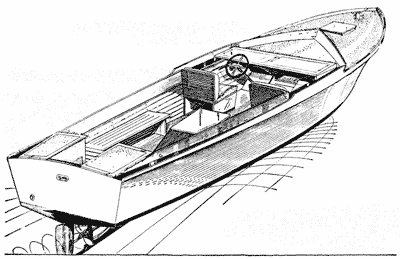
(click to enlarge)
Now a word about arrangement,
and then to building specifications.
On a lovely and nicely balanced
hull of the semi-planing, or more
nearly true displacement type, we
have a high-steeved chine as shown
on the lines plan. This
gives an easy riding boat. The bow
wave of this hull cleans off the chine
right around frame 3 according to the testing model I built and towed.
The crew sits at about this point and
so will ride dry,
Freeboard will give you shoulder-high protection behind the coaming,
which is nice in blowy weather. In
plan, as you can see from the perspective, (above) the forward deck is encompassed by a rail or bulwark a couple
of inches high. This deck drains rain
and spray outboard through a scupper at the visor break.
Up forward is an access hatch for
gear and to stand in when securing
ground tackle. All boats should have
this. Ventilation, security, escape,
stowage are all factors obtainable
only with such a hatch.
Next on the deck comes the visor.
This is primarily a spray and rain
break. By raising the bulwark to
visor height in way of the best riding
position in the boat, we thus surround the covering board, making
it a nest for the bows of a sprayhood,
without which no open boat is really
stormworthy.
That the visor is most practical is
attested to by its continuing popularity, and by the fact that the Navy
uses it freely today in all their stuff.
Coast Guard, too. Hence the term
"military type" which I use to explain why she is not the boat the
modern streamline-dreamline-screamline school of paper sailors yell about.
It seems to me that the prettiest
boat always results from being supremely functional. Let the hull
shape result from the bulk needed-
let the looks result from the way
good honest lumber wants to stream
when it is applied to that bulk, and
you've got something beautiful in
the sense that the boat's bulk is beautiful. The shape of the bulk alone
can be beautiful—not lines or profiles or sections. They are two-dimensional, and are only outlines.
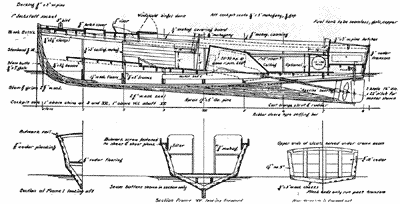
(click to enlarge)
Into Piute's bulk abaft the steering position, we put the motor. It is
placed on the center of buoyancy. So,
any motor of any weight can't then
unbalance the running characteristics I want you to have. Different
weights will then mean only slightly
different waterlines.
Access to the hull side, inboard, is
necessary in "working ship." We provide this by putting the break in the
seating arrangement just abaft the
steering position. Not only does this
provide side-of-hull access, but this
break also supplies floor space for
tools, oils and so on when the box is
off the motor.
Next come two good side seats.
These provide load trimming facilities when more than two use the
boat. They can also accommodate
sleeping bags. And with the spray
hood up on starry nights. Piute becomes a fine cruising boat for that
young couple who want to cruise
beach fashion; folk who are ready
for more boat than an outboard but
who cannot yet afford a cruiser.
Instead of running the side seats
to the transom, I've saved about
three feet for a catch-all lazarette.
This is in the form of full-depth
hatched lockers, port and starboard,
with a rope and Rear floor between.
Under the seat sits a seamless galvanized or copper fuel tank, holding
about go gallons, or enough for 125
miles of going on 20 to 25 hp at 1,000
to 1,200 rpm. In one of the lazarette
lockers one can stow a Primus stove,
pots, pans, dishes. The other can be
the ship's larder.
This gives you most practical accommodation. And engineering-wise,
it gives you length which you need
for easy going and it shortens the
cockpit while putting weight forward, where it is needed.
So much for arrangement, except
to explain the windshield forward: this folds back flat when you don't need it, and is protected by plywood
flats rabbeted into the glass frames.
When folded back flat this becomes
a chart table and helps protect the
cockpit.
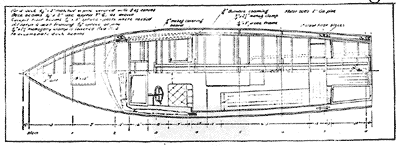
(click to enlarge)
Now for building the boat, and
her specs: as with all boats, you
must lay her down full size. This
will require a floor to work on. I
have seen boats of this length lofted
in a room half her length (24 feet-10 inches O.A.) by lofting the fore
half, then the aft half. It can be
done if you're mechanic enough.
And since this is hardly a beginner's
boat, and since anyone who has done
his first job of building will find
Piute easy to build, I'll skip the step
by step stulf and go to a general
outline.
She is best built bottom up. To
do this, run a line at a convenient
height above the base line and above
the sheer line so that, if the plan
were turned over, this line would
become the floor line. Loft out the
boat to the outside of planking as
the offset table shows, paying attention to the waterlines and getting
the frames curved as shown. This
is not hard to do.
Frames (topside) from one to six
have shape to them. Bottom frames
from one to four have shape, and
frames Five, six, seven and eight are
straight, keel to chine. The boat
will plank easier if the modeling
shown is kept. Beware the advice of
friend, neighbor or Mr. Expert who
says straight sections all over are
best. He has never, with his own
hands, streamed planking on a hull.
Lumber wants lo shape when bent.
Let's go with it!
The usual getting out of frames
and keel follow, taking special pains
to diminish the frames by the planking thickness, to expand the transom
to its true face along the raked
angle, and to get the transom bevels
correct.
Here's a good dodge on the frames:
The seam battens are not put in until
after the frames have been erected on
the floor, or on the sills, if you build
that way. So it is easiest to get out
the frames, diminished to planking
thickness, but leaving aft eighth of
an inch or so of material still to be
shaved. With the proper line for the
inboard face of the planking marked
on the frame, sink the battens to
proper depth. This will leave the
extra material between gains, or
batten pockets, so that you can take
a wood-block plane and face the
whole frame down to batten level.
The bevel will then come automatically.
Piute must be built where no rain
will hit her. Better allow neither
rain nor strong, direct sunlight. Such
things make the lumber walk, and
you can't preserve either measurements, or tightness.
After you've erected the frame,
stream the battens in, spacing the
pockets or gains on each frame
equally. These battens are 3/4-
inch x 1-7/8-inch (neat) spruce or
yellow pine, in one length. If an
occasional butt must be made,
stagger the joints so they are in far
ends of the boat. Use one 1-1/2-inch
No. 12 brass screw per batten per
frame.
It will be better to have the local
mill bandsaw your keel for you. They have the power and the tools.
All you'll need is an accurate plywood or latticed template for them
to work to. This keel should be of
oak, and is sided 2-5/8-inch (neat, not
commercial) . This dimension can be
readily effected on the mill's planer.
As shown on the scantling section,
the keel is held to the apron and
floor by a galvanized bolt 1/2-inch
diameter, blind plugged on each
frame. The apron will be 1-1/4-inch
Georgia pine, which you can easily
get one length, as this stuff grows
to nice heights without knots. The
floors are 1-1/4-inch white oak except
in way of the motor, where they
should be sided 1-1/2-inch and molded
to tie the frame heels together. The
frames are of 3/4-inch white oak,
3-inch molded and at the sheer ends
are 2-1/4-inch molded.
There is no need for gussets or
cheekpieces. The frames, if of oak
and of this face width, are well held
by three 3/8-inch galvanized bolts at
the chine corner. The chines are of
two pieces, inner and outer, of
Georgia pine in single lengths. The
inner, or flat piece, is 7/8-inch by
3-inch. The outer piece is 1-1/2-inch
by 1-1/2-inch. Two screws per frame,
of 2-inch No. 12 brass, will hold the
inner chine to the frame. The outer
member forms the chine corner, and
should be planed off to a hard, sharp
edge, to make the water clean off
quickly. It is a mistake to round the
chine. Fasten the outer chine to the
inner chine with 1-1/2-inch No. 10
brass acrews, deeply sunk and
bunged, on 4-inch to 6-inch centers.
The clamp, covering board and
bulwark scantlings are covered in the construction, or scantling section. Note that the forward clamp
is lowered. On this land the deck
beams.
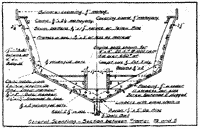
(click to enlarge)
The planking should be white
cedar, Maine white pine, or some
equally light, tough, workable wood
to finish 5/8-inch. Put on so as to
space the strokes evenly at each
frame, with battens under. The
fastenings should be 1-1/8-inch No. 8
brass screws on 4-inch centers,
bunged with pine bungs (obtainable at all marine hardware outlets
upon advance order) set in varnish
and lightly tapped into the bung
hole. Special bits are available that
will pre-drill lo proper screw size
and countersink for bungs in one
operation. Bungs are trimmed off
with a chisel later.
In connection with fastening, a
portable electlic drill is the clear
caper, but there is no law against
the "Armstrong" method, one at a
time. Thousands of boats have been
built by sheer elbow grease.
This covers the specs of the hull,
and since it is hull we are primarily
concerned with, and since the construction is the simple seam-batten
type with which nearly every one
who knows boats is familiar, not
much need be said as to method.
Obviously, you have to arrive at
the size and location of the parts.
This you do by laying the job down.
Obviously, too, these parts have to
be fastened, and erected so they can
be planked. As to fastenings, where
I have not been specific, use a screw
which, when sunk home, will come
within an 1/8 or 1/4-inch of piercing
the member. The coarser the thread,
generally, the greater the holding
power. Fine threaded screws are for
hardwood.
When the hull is planked, of
course, it must be planed, sanded,
the seams payed with white lead
primer and string caulked, and the
seams puttied and glazed. Old stuff,
and no need to repeat it here, except to caution about the caulking.
Roll in each seam only a light string.
Wood swells, and if the joints are
between 1 /32-inch and 1 /16-inch
apart inboard on the batten, the
job will swell tight. Caulking is only
a deterrent for launching leaks -
leaks induced by hull working.
Don't pound caulking cotton into a
seam. Wood to wood fits are the
tightest: if possible, work to tight
wood inboard, leaving 1/16-inch
outgage for the string caulk which
is rolled in with a caulking wheel,
and you'll have things ideal.
The rudder and strut deserve
special mention. The rudder can be
made of a bronze plate shaped as
shown, but it would be a higher
grade job to get out your own pattern and have the local foundry cast
one up. Columbia Bronze, Freeport,
L. I., has many rudder patterns, and
they should be able to get you one of about the area shown. You must make a pattern for the strut. It need not be a split pattern. But it should
be cast bronze, naval bronze.
The stern bearing is a Willis
Akerite, obtainable from the E. J.
Willis Co., 83 Chambers St., New
York City. This is the smoothest of
rubber bearings, I think, and the
shaft never wears hex-shaped.
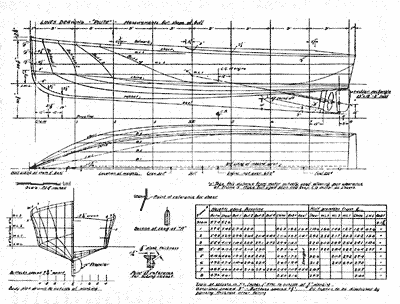
(click to enlarge)
All details of inboard construction
are straightforward carpentry, and
will be obvious from the sectional
views and from the arrangement
plan. In this department, as to personal latitude, I say, "God bless ye."
Done as shown, she'll be fine. But
if you want something else, so long
as weights of motor, crew and fuel are kept where they are on the lines
plan, you'll get a good boat.
Don't, however, go loading up the
interior with house lumber or use
any scantlings above what are called
for: i.e., 3/4-inch cockpit sole, 3/4-inch x 1-1/4-inch white oak seat risers,
main cockpit floor beams 3/4-inch x 3-inch spruce, etc. Lumber in
a boat gets wet, and wet lumber gets
heavy. Heft kills performance.
Now I can hear some letters winging my way asking the all-important
question, "What speed will I get
with my Piute if I put in lhe motor
you say?"
I hesitate on this. Speed of
amateur-built boats depends upon
two things: how closely the plans
are followed, and the degree of hull
finish achieved. If you follow the
plans right out the window, and if
you do a good sanding and a fine
paint job, you should get 16 to 18
miles an hour.
A contract job out of a shipyard
would go 18 to 20. William H.
Hand, Jr., a famous designer of this
type of boat, consistently got 20 to
21 miles an hour on hulls of similar
weight and displaccinent. It was a
matter of fairness and finish. But
suppose you find a good mill of the
Fig. 2 variety, around 4-inch x 4-inch
on 650 pounds and turning 1,000
rpm, then a three-bladed wheel 16-inch diameter by 22-inch pitch will
give you 16 real land miles per hour,
on nominal slip. Since this is equal
to the usual called speed of 20 mph,
it is good going. Any boat that fast
is really wiggling, and I should say
honestly you can expect that speed.
So there you have Piute, so named
after the old prairie Indian who
could go all day on the lope without
tiring himsell or his mount.

